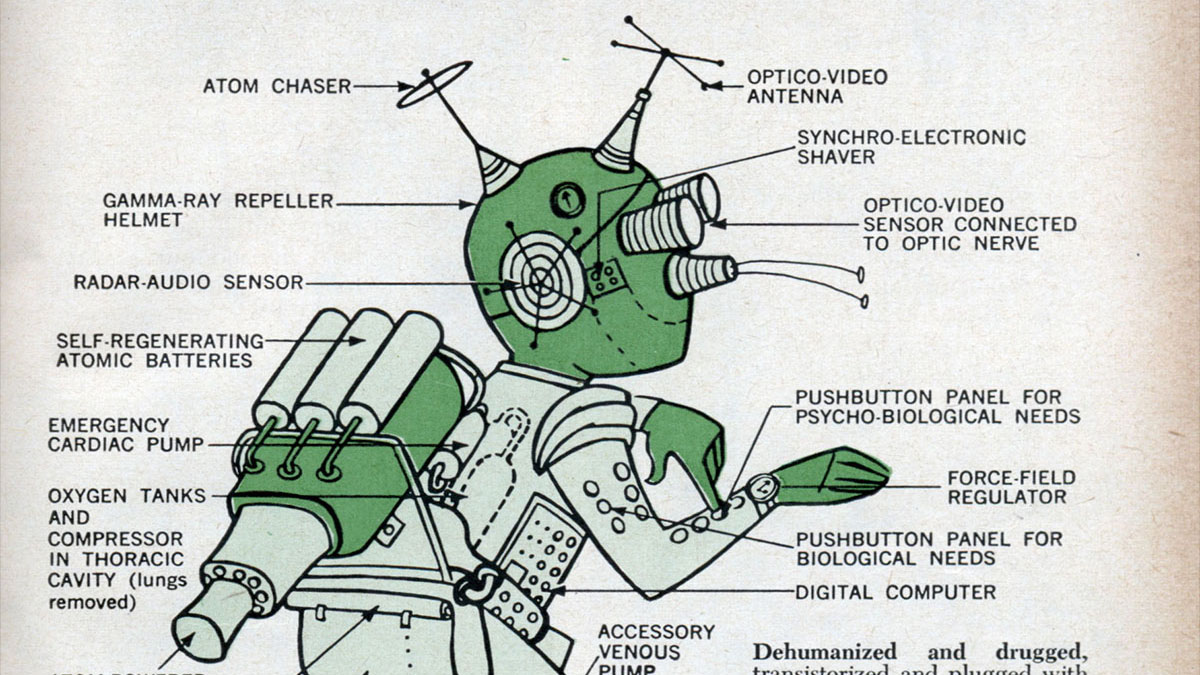behold the (terrifyingly badly designed) cyborg of the 1960s

Space is the lest hospitable environment for any living thing. Not only is there no atmosphere or gravity, it’s constantly awash in radiation deadly to anything alive and made of atoms. If we want to survive what would realistically be long and difficult journeys to other solar systems, we’ll need to be ready and willing to modify ourselves with everything from artificial organs to more or less giving up our entire bodies and hooking our brains up to machinery. None of these ideas are new. In fact, they’ve been around since the dawn of human spaceflight, and we can see one of the first blueprints for space-proofing ourselves in the illustration found in an article featured in Popular Science in 1963, in which two doctors tried to take a stab at how we could explore other worlds without being poisoned by radiation and stressed far beyond our limits by takeoffs and landings.
While it would be great to say that we’ve been able to build on the design you see, if you look at the captions, it quickly becomes obvious that the concept is pure cargo cult science. What is an atom chaser? Is there such a thing as a “gamma ray repeller” other than a magnetic field? How would atomic batteries self-regenerate if the decay of radioactive matter is what would power the cyborg? Why would you possibly put an active source of heat and radiation literally on the back of a shell trying to protect a human’s vital organs, a shell that now has to be heavily shielded not to create a mini-Chernobyl inside the cyborg’s body? And last, but definitely not least, why would the cyborg have to be heavily drugged? If anything, you’d want your cyborg astronauts extremely alert and vigilant at all times while they explore the final frontier.
Now, before you respond with “well, if you’re so smart, why don’t you design your own space-faring cyborg,” I’d like to first point out that I actually did take a stab at it, and secondly, note that the doctors who created it deserve some slack. After all, they were missing more than half a century of exponentially accelerating progress to understand what was possible and what was just fanciful fiction or outmoded hypotheses. Organ transplants were just starting and the idea of hooking up a brain to a computer was still considered science fiction, many decades from the very first tentative experiments. What we’re seeing is a best guess from the dawn of the age of space exploration and it not only illustrates the speculative notions of the time, but the vast gap between popular and real science.
This example shows us that while popular science may be far ahead of experts and researchers, it’s also far from accurate and is often based largely on the imaginations of those whose ideas capture the headlines rather than actual research. So, next time you’re presented with renders and cutaways of amazing technology we’re told is on the horizon, like, say, hyperloops, try to remember this illustration of the Man of Tomorrow and just how far from accurate or realistic it was. Then ask yourself, do some of the labels and terms you’re seeing flying around sound a bit jumbled or mysterious? If they do, it’s probably a safe bet that you’re looking at an idea that’s highly unlikely to ever materialize, and if it does, it’s going to look very, very differently from what we were originally being pitched.





